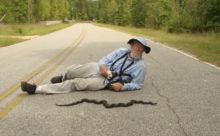"Where Do They All Go?" and the Folklife Documentary Film
Where Do They All Go? and the Folklife Documentary Film
By Daniel W. Patterson
To understand how the film Where Do They All Go? relates to other documentaries on the Folkstreams website we need to recall the terrain covered by the term folklore. The word melds two subjects. One is the lore—knowledge—passed from one person or generation to another by mouth or demonstration. This way of sharing and knowing operates under a cluster of distinctive laws, affects behaviors that range from the trivial to those crucial for physical, psychic, and social survival, creates its own recognizable aesthetic forms, and across time has crossbred in numerous ways with writing, print, more recent technologies, and the activities and knowledge that they have bred. The other subject—folk—refers to groups with this non-literate way of sharing knowledge. This wing, like the other, covers great historical complexity.
In the deep past, before the invention of writing, folk included everybody. All knowledge and culture were carried in memory and shared orally and by enactment. But the diversity of conditions under which one group or another lived caused some societies to remain fairly simple in structure and others to become highly complex. In the latter, individual gifts, interests, and opportunities led people to specialize—some for example, in making tools or weapons or clothing or pots or musical instruments, others in accumulating knowledge about plants good for food or for medicine, others in learning laws or genealogies, still others in creating or passing on songs or comic tales or legends or heroic epics or long accounts of cosmic origins, yet others in leading rituals, practicing warfare, or ruling. Varying forms of lore were known to nomads or villagers, craftspeople or peasants, males or females, children or adults. Other forms developed to serve priests, aristocrats, rulers, and their cadres.
Literacy has broken into these worlds, first here, then there, across many centuries. The earliest writings might record lore that previously had circulated orally and canonize it as sacred text or might record or remodel the sophisticated narratives that had entertained rulers and their circles—Gilgamesh, for example, in ancient Mesopotamia, Beowulf in early medieval England. But literacy enhanced the standing of the socially powerful and sped social change. Groups distant or excluded from the centers of literacy and power retained more of the older oral culture and the world views it carried. The literate have accordingly wavered between veneration for ancient texts and contempt for oral culture they saw as heathen or ignorant or unrefined or childish.
A classic example of this latter attitude in Shakespeare’s England is Sir Philip Sidney’s account of hearing an old ballad about a battle between the Scots and the English fought at Otterburn in 1388. Although performed by a blind street singer with “no rougher voice than rude style,” it moved Sidney’s heart more “than with a trumpet,” but he called his feelings evidence of his “own barbarousness.” After the printing press gradually diffused literacy more and more widely through various societies, some educated people began to take interest in the oral lore, impelled by one intellectual movement or another, including antiquarianism, neoclassicism, romantic nationalism, political egalitarianism, and dislike of industrialization. The interests were enriched in the nineteenth century by the growth of academic disciplines like linguistics, literary studies, and social history, followed later by musicology, folkloristics, anthropology, and ethnomusicology. Twentieth-century economic and political conditions and movements gave point to the interest. All of these supplied perspectives on marginal cultures and their traditions and also affected the lore itself.
Whereas material culture—a pot, a quilt, a carving, a painting, a house—may survive as itself, all things dependent upon ear and mouth survive only through their encounters with writing or recent technologies for preservation. For many of the old traditions the recording machine and still and motion-picture cameras arrived in the nick of time, just as, in the United States for example, the singing of ballads and work songs and the telling of lengthy complex tales by the hearthside began to fade. Some tradition bearers—for example, Shakers and shape-note composers expropriated musical literacy and made it a vehicle for their own oral cultures. Blues and country musicians did the same with factory-made instruments. Others have done the same with the technologies for recording sound and moving images. All told, the pen, print, and sound recordings, have captured huge repertories of ballads, Shaker spirituals or African American gospel music, blues or bluegrass from nearly the time of their emergence. The new technologies, moreover, added means of discovering, preserving, studying, and sharing the oral traditions that were superior to the written word. They capture, as the pen cannot, the nature of vocal and instrumental styles, of facial expression and bodily movements, of interactive social roles and their ancillary arts like foodways and dress. You find all of these in the documentary films on Folkstreams.
The spread of literacy and of new technologies, however, also undercut the oral lore itself. Gaining literacy and access to mass culture, many individual tradition bearers or whole cultures escaped into easier lives, leaving the old lore and ways behind. Others fell under unfriendly religious, social, economic, or political domination. But none of this brought a total loss of oral culture. While some groups have yielded to “cultural gray-out,” others define their oral traditions as crucial to their identity and prize them along with their sophisticated modern culture. And people studying orally transmitted knowledge and arts have come to grasp that every social group has its oral lore. If few groups now live in completely oral cultures, most of us live in ones more mixed. Even highly literate and socially powerful people shift into distinctly oral activities in some areas of their daily lives.
The cord on which all of these phenomena are strung is social change. The viewer will see a thousand faces of change on Folkstreams—and will spot a number of them in Davenport’s film Where Do They All Go?
